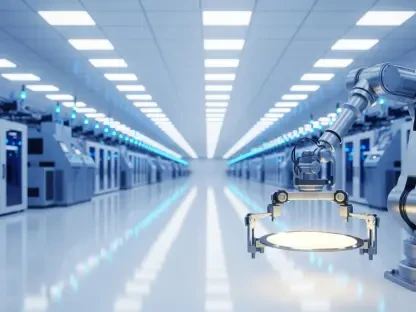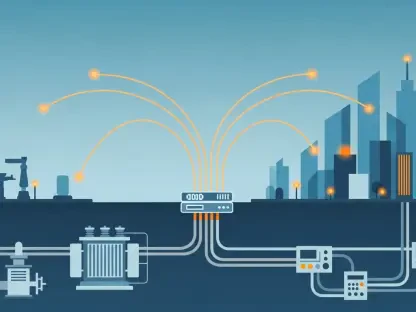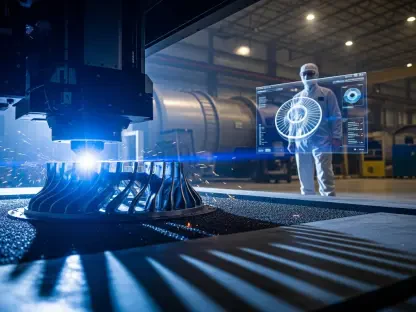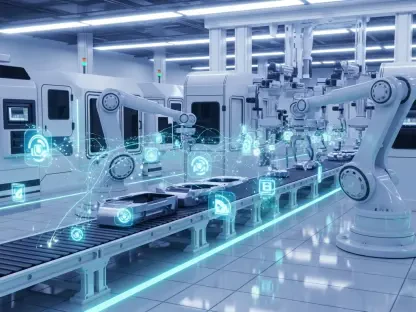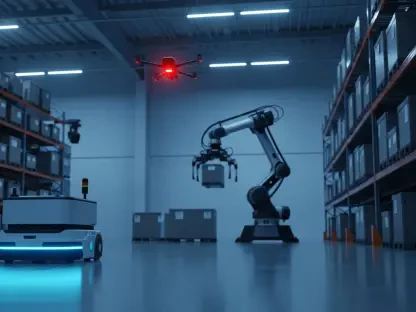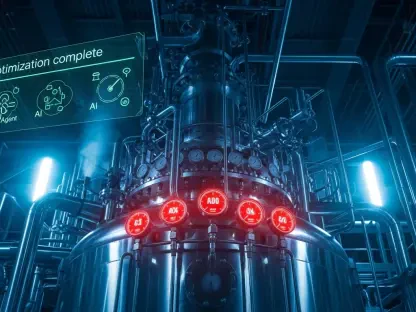In the high-stakes arena of modern warehousing, where the demands of e-commerce and rapid delivery are unrelenting, technology has emerged as a critical ally for staying competitive. Autonomous Mobile Robots (AMRs), often referred to as order fulfillment robots, are at the forefront of this transformation, reshaping how warehouses manage the ever-growing challenges of efficiency and scalability. These innovative machines are not merely gadgets but pivotal solutions addressing some of the most pressing issues in logistics today. Labor shortages, coupled with the exponential rise in online shopping, have placed immense pressure on facilities to fulfill orders quickly and accurately. AMRs are stepping into this gap, offering a way to streamline operations while enhancing human capabilities. Imagine a bustling distribution center where robots glide seamlessly alongside workers, handling repetitive tasks and ensuring orders are picked and packed with precision. This scenario is becoming the norm, marking a significant shift from traditional manual processes to a collaborative, tech-driven approach. The impact of these robots extends beyond speed, touching on worker safety, operational flexibility, and the ability to meet stringent customer expectations. As the industry grapples with fluctuating demand and workforce constraints, the adoption of AMRs represents a revolutionary step forward, promising to redefine the very foundation of warehouse management with smarter, more adaptive solutions.
Tackling the Core Challenges of Modern Warehousing
The warehouse sector is facing a perfect storm of challenges that demand innovative responses. Labor shortages have become a persistent hurdle, with many facilities unable to staff enough workers to keep up with the surge in e-commerce orders. Industry reports highlight a stark reality: a significant percentage of operators have had to decline business opportunities due to insufficient manpower. This scarcity of labor is not a fleeting issue but a structural problem intensified by seasonal peaks and unpredictable demand patterns. The financial implications are substantial, as unfulfilled orders translate directly into lost revenue and dissatisfied customers. Automation, therefore, is no longer a luxury but a critical necessity for survival in this competitive landscape. AMRs provide a lifeline by taking on labor-intensive tasks, allowing warehouses to maintain throughput even with a reduced workforce. Their ability to operate continuously without fatigue ensures that operations can scale to meet demand spikes without the need for extensive hiring efforts.
Beyond staffing woes, the process of order picking stands out as a primary bottleneck in fulfillment operations. Recognized as the most time-consuming and costly aspect of warehousing, picking directly influences whether a facility can meet tight delivery windows and maintain accuracy. With customer expectations for same-day or next-day shipping becoming the norm, the pressure to optimize this process has intensified. Studies indicate that improving picking efficiency is a top priority for warehouse managers over the coming years, from 2025 onward. AMRs address this challenge head-on by automating the movement of goods and guiding workers to precise locations, thereby slashing the time spent on each order. Their integration into daily workflows not only boosts productivity but also minimizes errors, ensuring that the right products reach the right customers. This dual benefit of speed and precision underscores why order fulfillment robots are becoming indispensable in overcoming the operational hurdles that define modern logistics.
Unpacking the Workflow Models of AMRs
Order fulfillment robots operate under distinct workflow models, each with unique implications for warehouse efficiency. One prominent approach is the “Find Me” model, where multiple robots function within designated zones, and human pickers must seek out an available unit to initiate tasks. Often signaled by visual indicators like flashing lights, these robots wait for workers to approach them with orders ready to process. While this swarm-like setup can handle high volumes in larger facilities, it risks inefficiencies when zoning isn’t meticulously planned. Pickers may waste time searching for robots, especially during peak periods when coordination falters. Additionally, the dependency on robots to trigger tasks can create bottlenecks if the allocation of resources isn’t dynamically managed. Despite these drawbacks, the model remains viable for operations with the infrastructure to support extensive zoning, offering a glimpse into how early automation strategies prioritized robot-driven workflows over human autonomy.
In contrast, the “Follow Me” model pairs a single robot with a picker, guiding them through the warehouse to specific pick locations using a mounted tablet for instructions. This one-to-one relationship simplifies the interaction but introduces limitations tied to the robot’s pace. Workers are often constrained by the machine’s speed, unable to move ahead or multitask effectively. Furthermore, the reliance on frequent tablet checks for updates or confirmations can lead to unnecessary delays, as pickers must pause to interact with the interface. This model, while easier to implement in smaller settings, struggles to maximize efficiency in high-throughput environments where every second counts. It represents a transitional approach in automation, bridging manual processes with robotic assistance but falling short of fully optimizing human-robot collaboration in dynamic warehouse settings.
A more advanced alternative is the “Meet Me” model, which redefines the synergy between robots and workers. In this system, pickers and robots operate independently, converging at predetermined locations only when necessary. Supported by mobile apps and visual task allocation tools like put-to-light shelving, workers receive real-time pick information without being tethered to a specific robot. This independence eliminates waiting times and empowers employees to work at their own rhythm, significantly enhancing productivity. The model’s flexibility also reduces the need for extensive managerial oversight in coordinating resources, as the orchestration software dynamically assigns tasks. By prioritizing autonomy and seamless interaction, this approach addresses many of the shortcomings of earlier models, positioning it as a forward-thinking solution for warehouses aiming to balance efficiency with adaptability in an era of fluctuating demands.
Boosting Productivity and Worker Well-Being
The transformative power of AMRs extends far beyond operational speed, deeply impacting the worker experience in warehouses. With an increasing reliance on temporary labor to fill staffing gaps, the need for intuitive, easy-to-learn systems has never been more critical. Many workers entering the industry lack extensive training or long-term commitment, making simplicity in automation tools essential. AMRs, particularly those employing user-friendly interfaces like mobile apps, drastically reduce the learning curve. Visual cues and straightforward instructions ensure that even new hires can contribute effectively from day one. This accessibility not only boosts operational continuity but also alleviates the burden on supervisors who would otherwise spend significant time onboarding staff. By embedding simplicity into their design, these robots help warehouses maintain agility in the face of high turnover rates and seasonal workforce fluctuations.
Equally important is the focus on ergonomics and safety that AMRs bring to the table. Warehouse work is physically demanding, with repetitive tasks and heavy lifting leading to a notable rate of injuries among employees. Robots capable of handling substantial payloads—up to 450 pounds in some instances—take on the brunt of this labor, significantly reducing physical strain on workers. This shift not only lowers the risk of workplace injuries but also fosters a healthier, more sustainable environment. Beyond physical benefits, the reduction in repetitive tasks allows employees to engage in more varied, skill-based activities, potentially increasing job satisfaction. The emphasis on worker well-being reflects a broader industry trend toward human-centric automation, where technology serves to enhance rather than replace human effort.
Another key advantage lies in the minimization of downtime, a critical factor in maintaining warehouse throughput. Traditional robotic systems often require periodic recharging, pulling units out of service and creating gaps in productivity. Modern AMRs, however, incorporate innovations like hot-swappable batteries that allow for continuous operation across extended shifts. This means robots remain active during peak demand periods, ensuring that order fulfillment keeps pace with customer expectations. The ability to sustain uninterrupted workflows is particularly vital in e-commerce settings, where delays can ripple through the supply chain and impact brand reputation. By addressing downtime, these robots enable facilities to maximize their output, demonstrating how technological advancements can directly translate into competitive gains in a fast-moving market.
Shaping the Future of Logistics
Reflecting on the journey of warehouse automation, it’s evident that order fulfillment robots have already begun to redefine operational paradigms by tackling persistent labor shortages and the complexities of order picking. Their integration marked a turning point, as facilities shifted from manual dependency to a hybrid model of human-robot collaboration. Each workflow approach, whether the zoned efficiency of the “Find Me” model, the guided simplicity of “Follow Me,” or the independent synergy of “Meet Me,” contributed to a broader understanding of how technology could alleviate industry pain points. The focus on enhancing picking accuracy and speed addressed immediate needs, while innovations in power management and ergonomic design laid the groundwork for sustainable progress. These advancements collectively reshaped how warehouses responded to the unrelenting pace of e-commerce growth.
Looking ahead, the next steps involve leveraging these robotic solutions to build even more resilient and adaptable logistics networks. Warehouse operators should prioritize scalable systems that can evolve with demand, investing in models like “Meet Me” that offer flexibility without requiring extensive infrastructure overhauls. Collaboration between technology providers and industry leaders will be key to refining AMRs, ensuring they continue to meet emerging challenges such as tighter delivery windows and personalized order requirements. Additionally, focusing on data-driven insights from robotic systems can help optimize workflows further, identifying inefficiencies before they become bottlenecks. As the landscape of warehousing continues to evolve, embracing these robots as strategic partners rather than mere tools will be essential for staying ahead in a competitive, ever-changing market.


